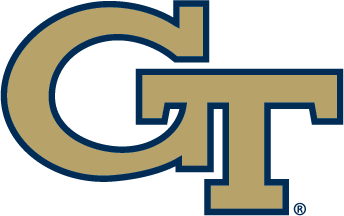May 17, 2011
By Matt Winkeljohn
Sting Daily
Debate may continue on whether coaching is more a matter of art than science, and Bryan Shelton will do nothing here to end the argument.
He’s pulled from both in steeling the Georgia Tech women’s tennis team for a postseason push that had them on a plane Tuesday night heading for Stanford and the NCAA championships.
With four players returning this season joined by five newcomers, Shelton and assistant Alison Silverio have moved pieces around as if playing chess – with themselves.
They’re onto something; when Tech (15-10) wins the doubles point – which requires winning two of three doubles matches – the Yellow Jackets are 15-0 this season. When Tech loses the doubles point, well, you do the math.
Is it any wonder that the Jackets have spent the better part of the past three weeks of practice working on doubles?
Why the disproportionate focus? For starters, as junior Caroline Lilley said, “doubles really sets the tone in college tennis.”
So there’s that.
Plus, Shelton said he’s learned in his 12 seasons as Tech’s coach (all of which have ended in the NCAA tournament, with the Jackets winning it all in 2007) that he can get more done working on doubles late in the season.
Read along and decide: art or science?
“When final exams come around, and we’ve already had the ACC tournament and you’ve got this period of time where you were really focused on academics . . . when you start focusing on doubles and team interests we get more done. We don’t always get the return [on singles],” he said.
“These girls are not going to forget how to hit a groundstroke, and how to set up a singles point and stuff like that. That’s stuff that they’ve spent most of their tennis life working on. They’ve spent much fewer hours working on doubles.”
To summarize, at least partly, it is Shelton’s opinion that the women are more engaged at the end of the year when involved in joint activities rather than solo work.
Tech has struck gold with the pairing of newcomers Lilley and Jillian O’Neill at No. 1 doubles, where the juniors are 8-1 in dual action.
Lest one figure that the best way to build a solid doubles team is simply to pair two good players together, again there is some art and some science involved.
First, the analytical angle:
“I don’t hit my volley as well as Jillian hits her volley. I can return a little bit better than Jillian,” said Lilley, who transferred from Kentucky. “If you match your strengths with someone else’s weaknesses, and hopefully their strengths coincide with your weaknesses that can be a good thing.”
Lynn Blau, who has found success with Elizabeth Kilborn at No. 2 doubles, elaborated when asked about whether pairing a good baseliner with a solid net player makes sense.
“That is actually a really good combination because the person at the baseline can set the person at the net up,” she said. “If you have two players that are more identical that would not be as beneficial. I match up really well with Elizabeth.
“She’s really good from the baseline, and she can set me up when I’m at the net. Her serving is really good, too. Some people match up right away.”
The “match” goes beyond whether two players’ skills complement each other and extends to the way they relate on and off the court. Here, art.
Lilley, for example, may be as intense a player as Shelton has had in recent years. O’Neill? Not so much. In this game, opposites attract.
“When you’re matching styles and strengths and weaknesses, it’s an emotional comfort level in finding the right balance,” the coach said. “You may have one player who is high-intensity/high-energy if you put another player exactly like that you’re in trouble. When it’s good, it’s great, but when it’s bad it’s terrible.
“You’ve got to balance those things out a little bit. We were able to do that at No. 1. We’ve got an extremely intense Caroline Lilley playing with a relatively slow-heartbeat Jillian O’Neill. One can calm the other down a little bit, and the other can rev the other up. It took us a while to find that combination this year.”
Despite their success, Lilley and O’Neill are out of luck for part of the NCAAs. After the team competition, there will be men’s and women’s singles and doubles competitions apart from the team tournaments. Tech’s Guillermo Gomez and O’Neill have been tabbed for singles, and Juan Spir and Kevin King in doubles.
But, “It took us a while to find that combination [of Lilley and O’Neill],” Shelton said. “Unfortunately for them it was about three matches too late. They only played seven matches together at the end of the season.
“Their ranking is 18 [pairs] get into the tournament but you need 10 matches. The selection process began before the ACCs. Fortunately for them, they’re both juniors and they can try it again next year.”
Blau noted that on the court communication, much of it non-verbal, is key to success.
Shelton would tell you that preparation matters as much, and all that time he and Silverio have spent on doubles recently has – even more than usual for the late-season push — paid dividends which the Jackets hope will again show Friday when they meet ACC rival Duke.
Now, back to the science-art debate.
Much of the recent doubles practice time has been put in for more than forging chemistry and communication. There’s been considerable – and somewhat dramatic – strategy at play.
Better to let Shelton explain.
“For us it involved building the entire practice every day around helping our team become better doubles players,” he said. “We designed drills. For instance, one thing we spent a ton of time on was second serve. We changed their position so they’re a couple feet inside the baseline [when receiving] instead of a step or two behind the baseline.
“We worked on them attacking the ball and . . . following that ball to the net. Now, instead of taking a ball that has peaked they’re taking the ball on the rise. That takes time away from the opponent.”
That’s not natural for players who’ve spent the bulk of their careers to this point playing and practicing singles. There are muscle and mental memory factors involved.
“You need to repeat that a number of times because they’re not used to taking the ball so early,” Shelton said. “We really decided we’re going to start attacking people’s second serves because we recognized during the season that a lot of people’s second serve is weak.
“We spent two and a half weeks repeating that over and over and over, and it paid off huge for us. If we just spent a few minutes a day on it in practice it wouldn’t stick under pressure so we spent an inordinate amount of time on it. We won a much higher percentage of return points on second serves. The teams that are winning points on second serve . . . that team is going to win.”
So, is that art or science? Both?
How about this?
“You’re also going to put pressure on yourself [by moving up even more than usual to take that second serve]. Your reaction time was just cut [so] you need a more compact backswing,” Shelton said. “You can’t take the big backswing that you’re accustomed to because you don’t want to double-dip in too many areas.
“You don’t want to take away your time and try to hit big, or try to hit the ball close to the line. You’ve got to create a margin [elsewhere]. You can’t get greedy and try to take the ball early, try to hit the ball extremely hard and try to hit the ball close to the line. We’ve got to have a target that has some margin in it.”
That part is definitely science.
What do you think of the rest of it? I think it’s more art than science, but healthy doses of both. Send your thoughts to stingdaily@gmail.com.
–RamblinWreck.com–









